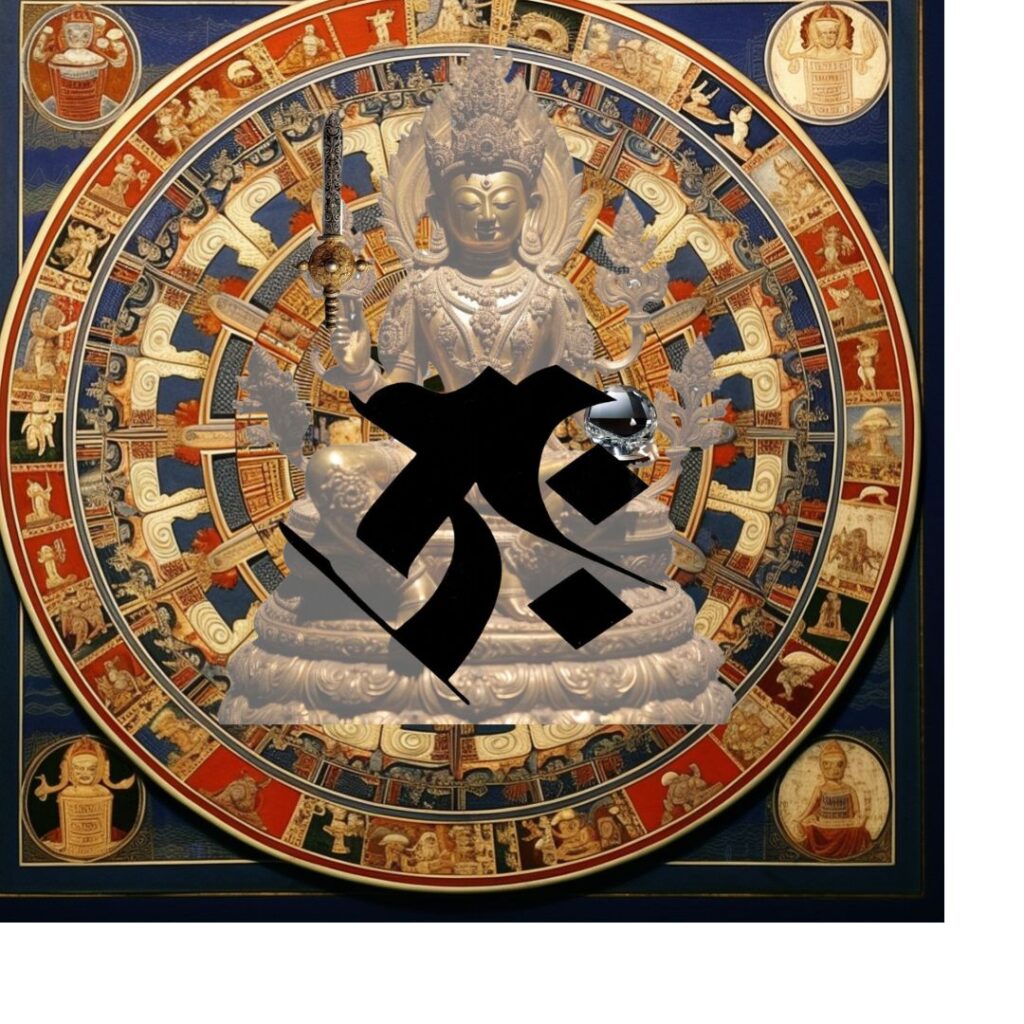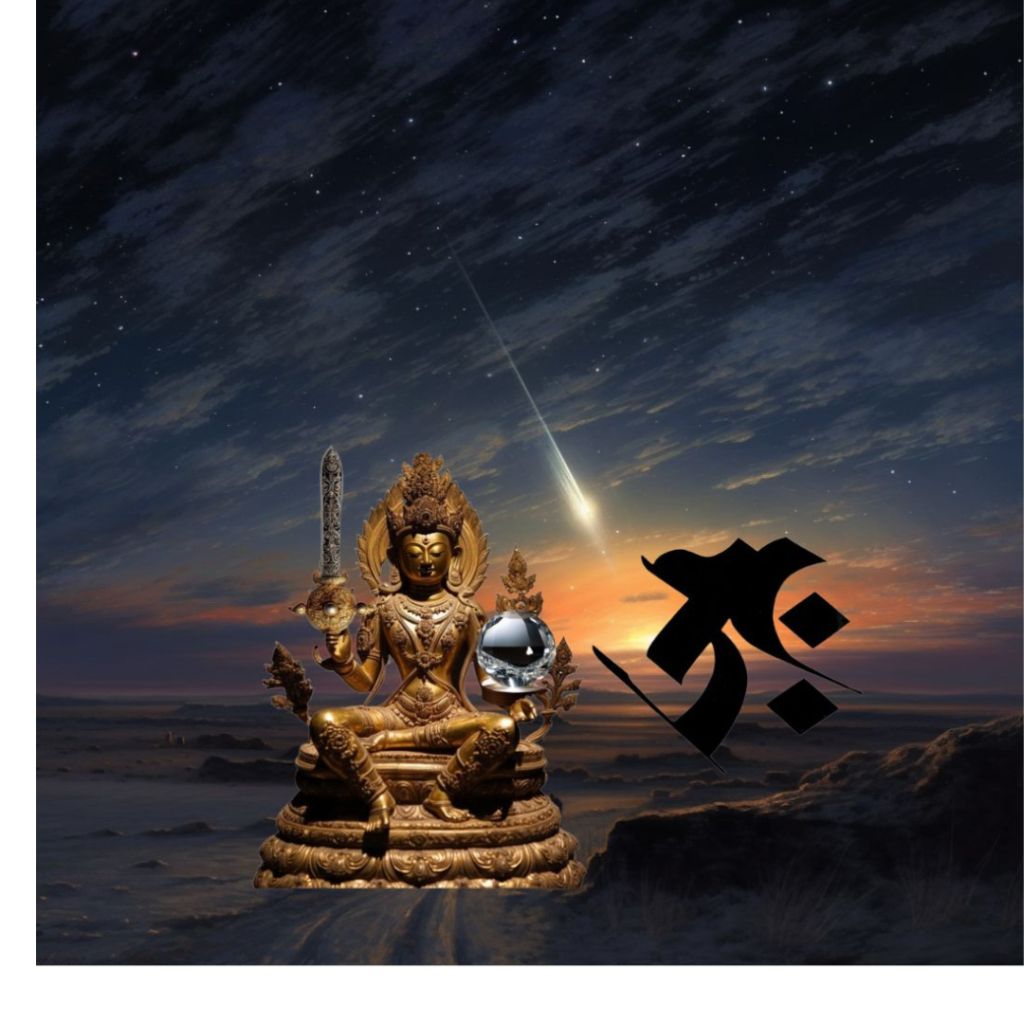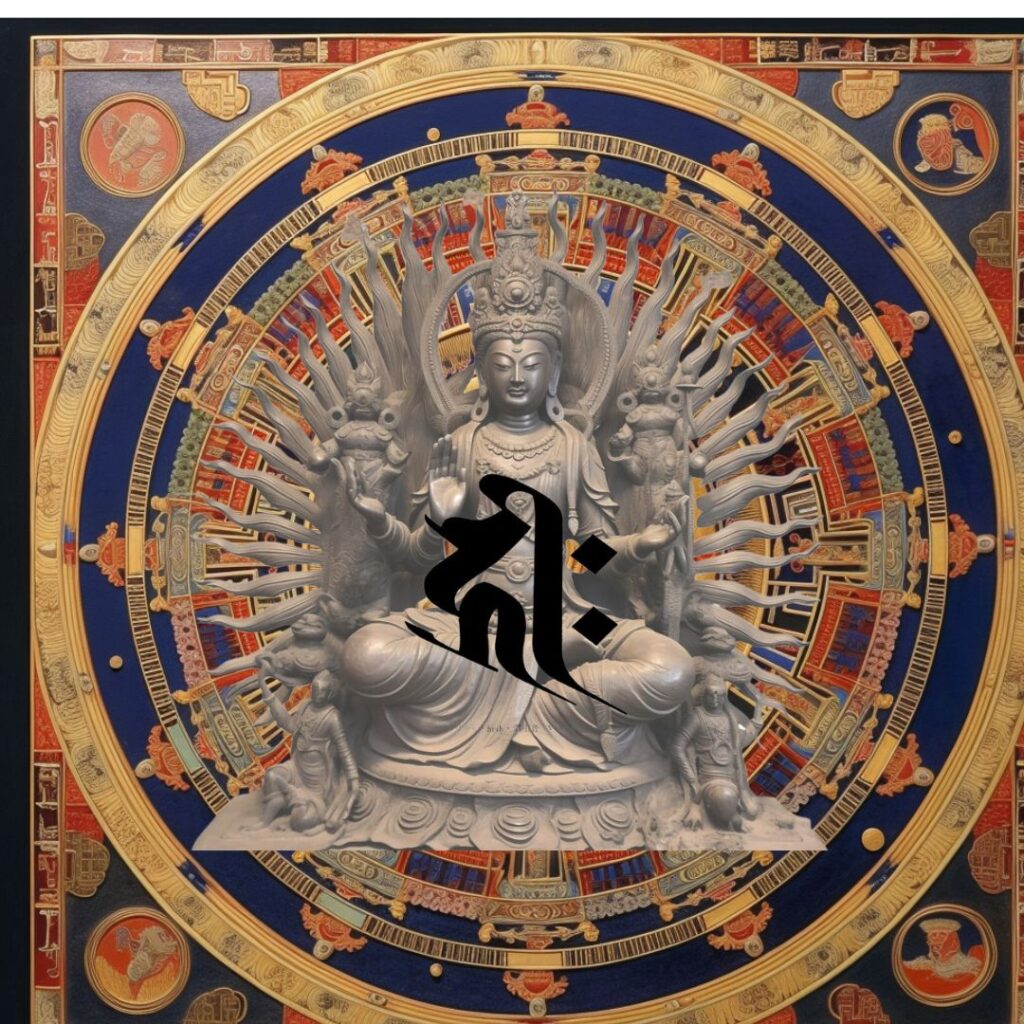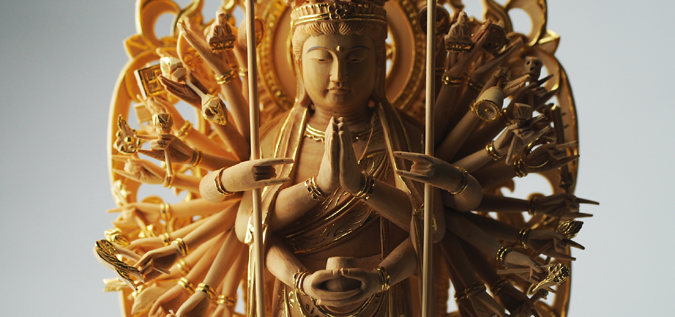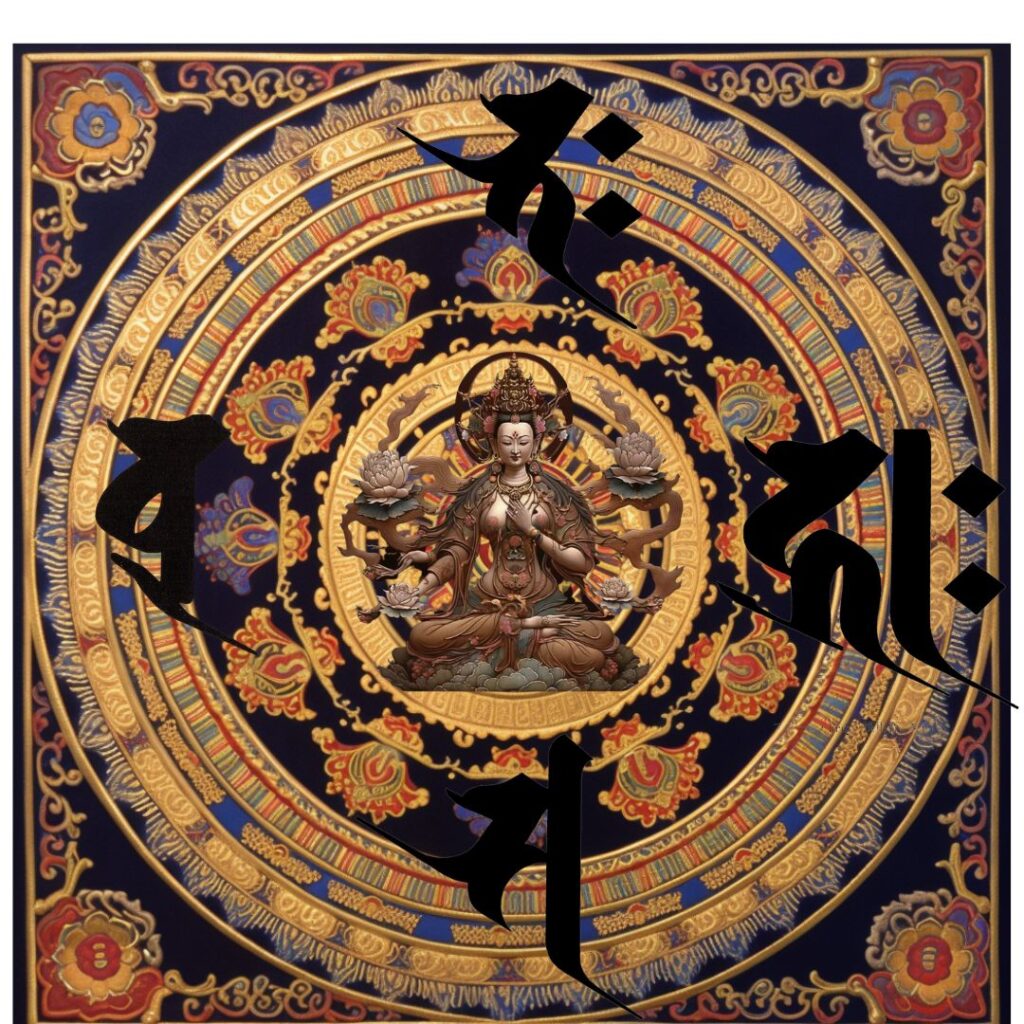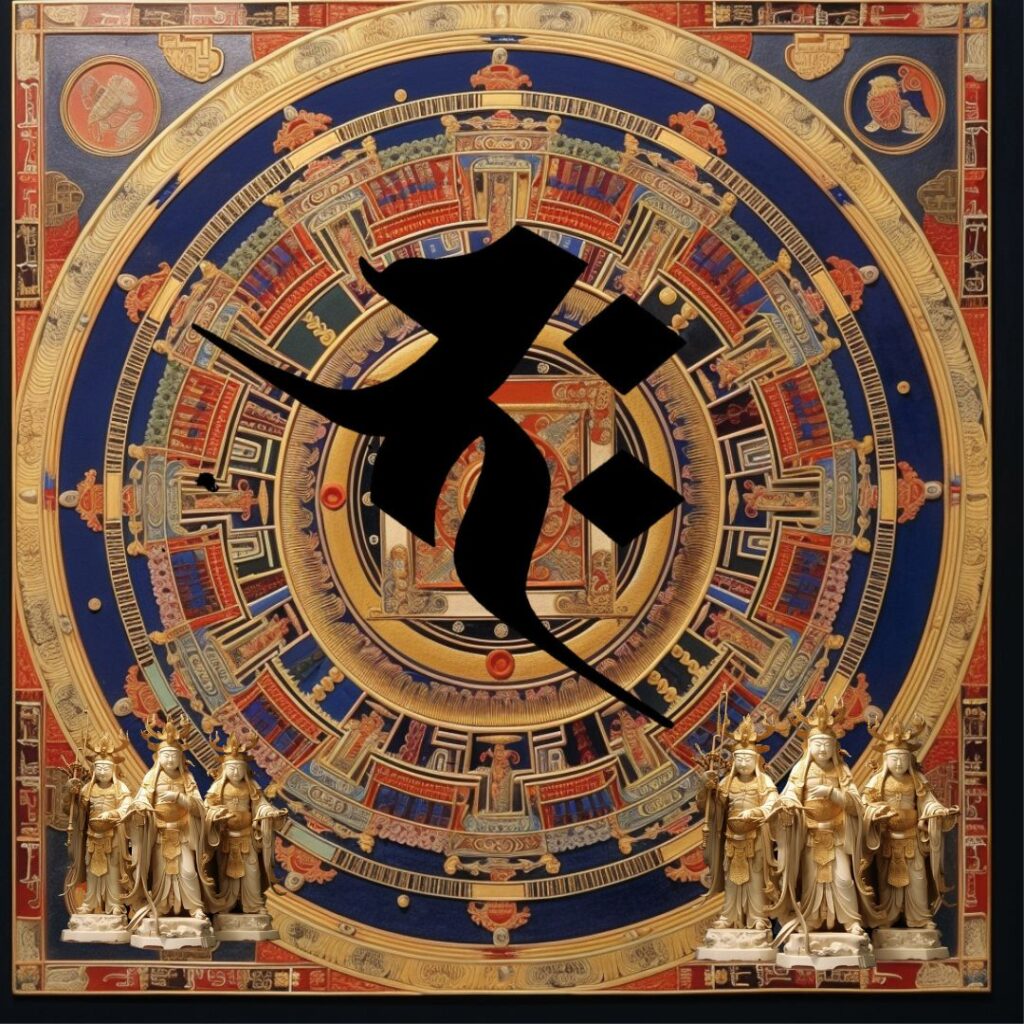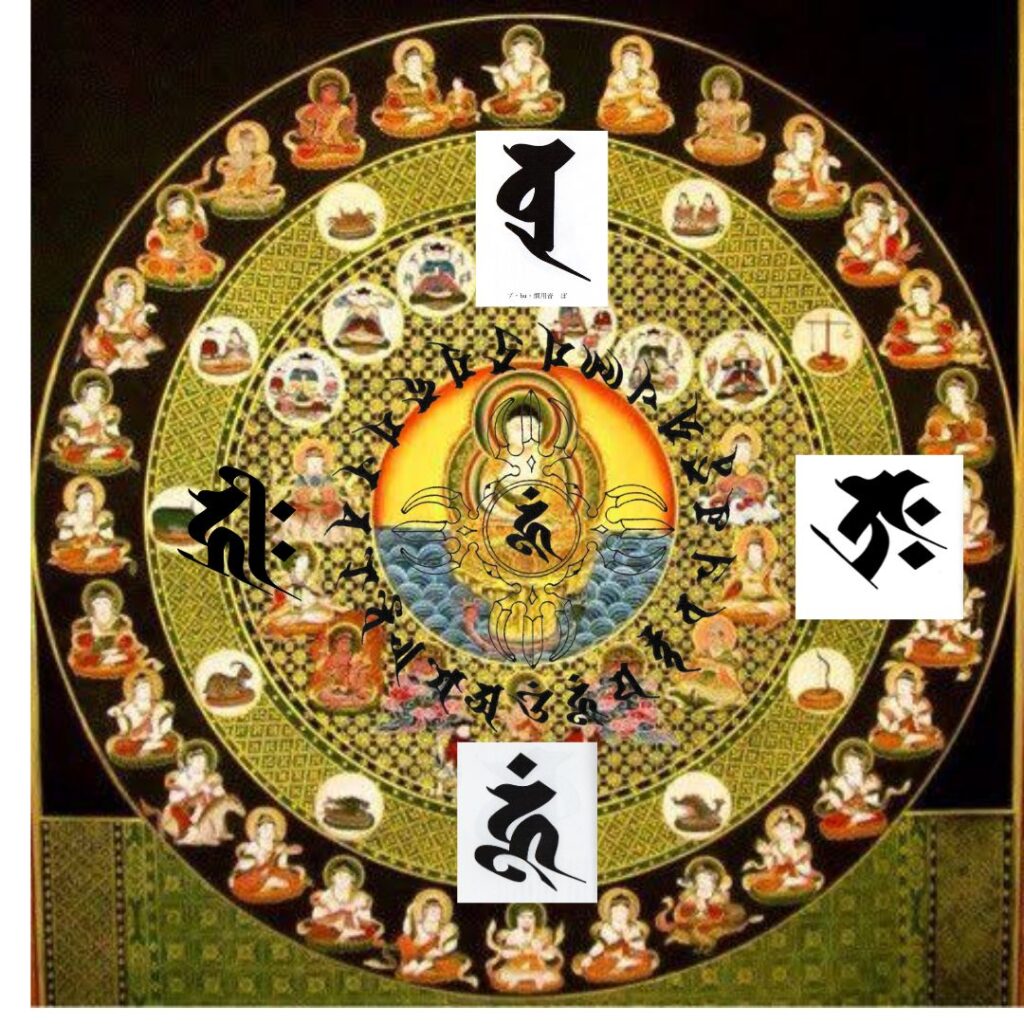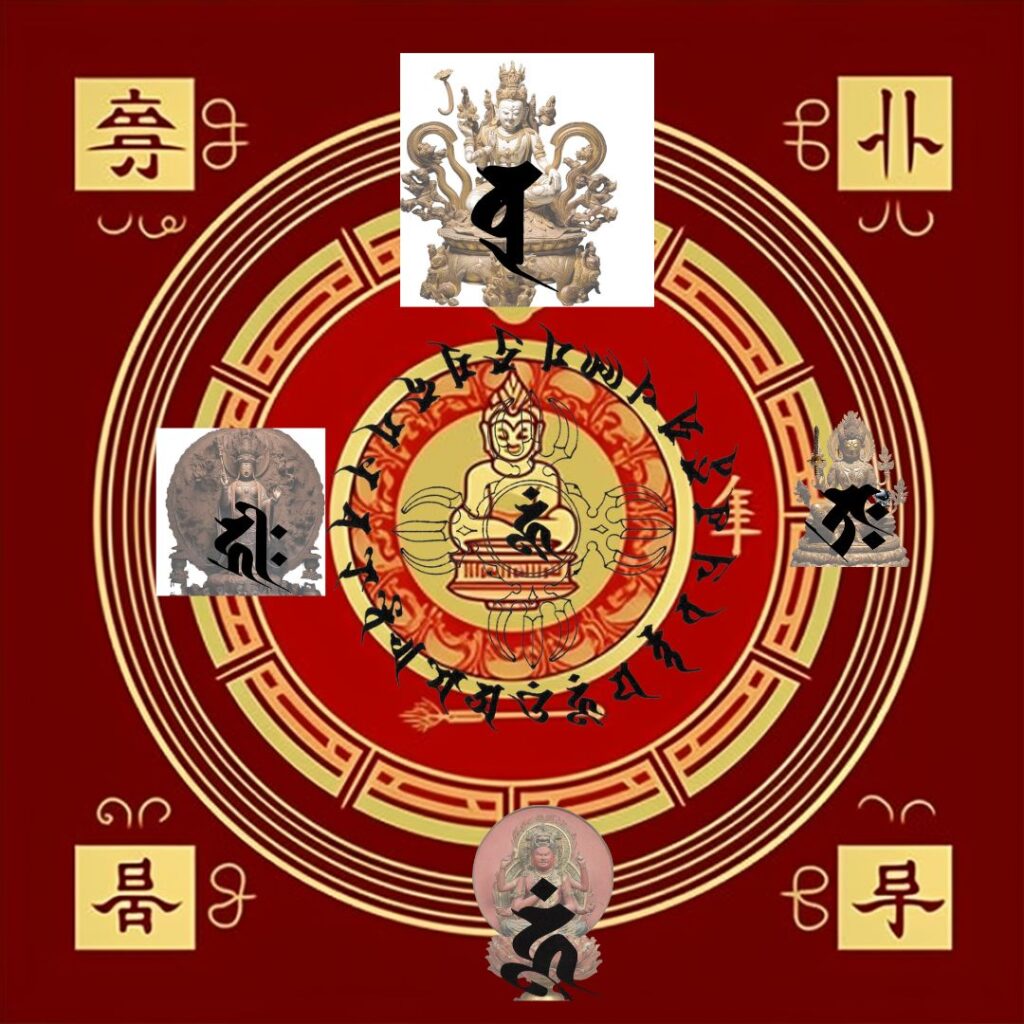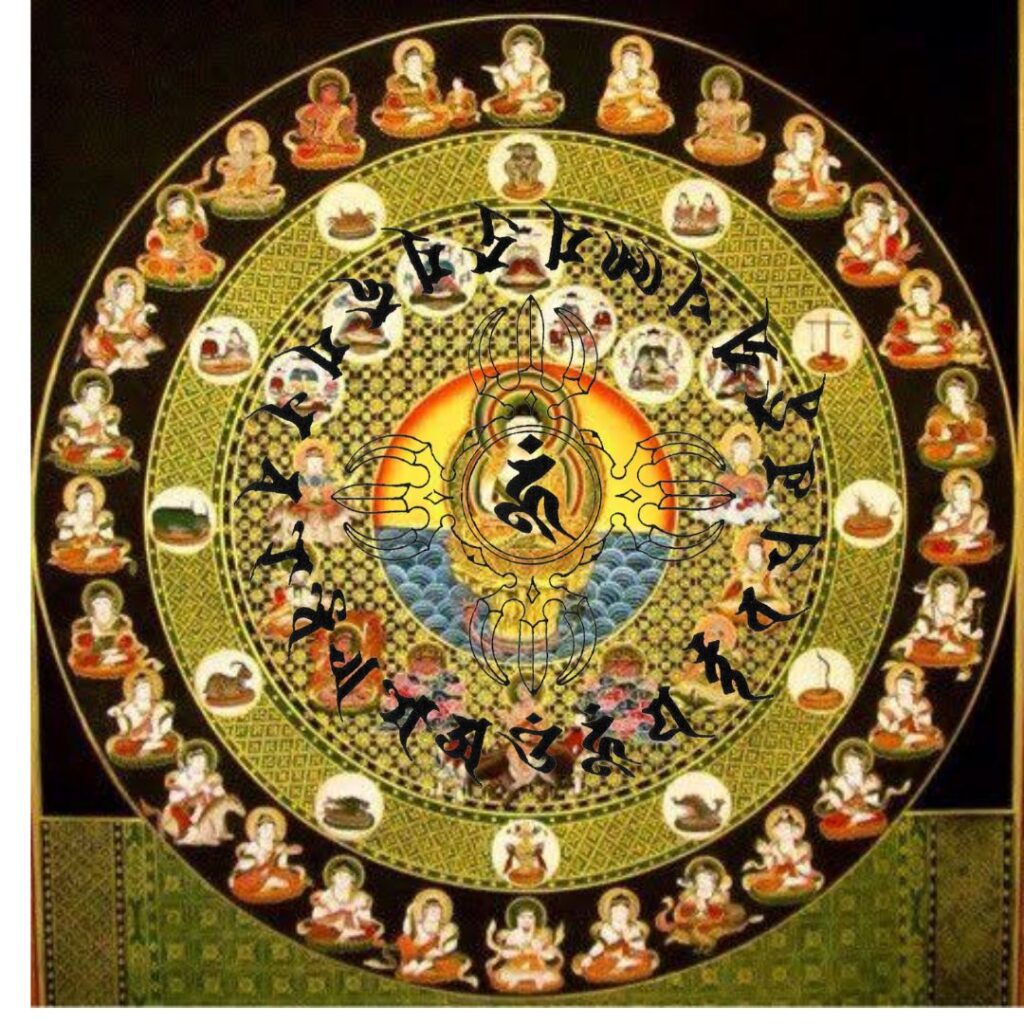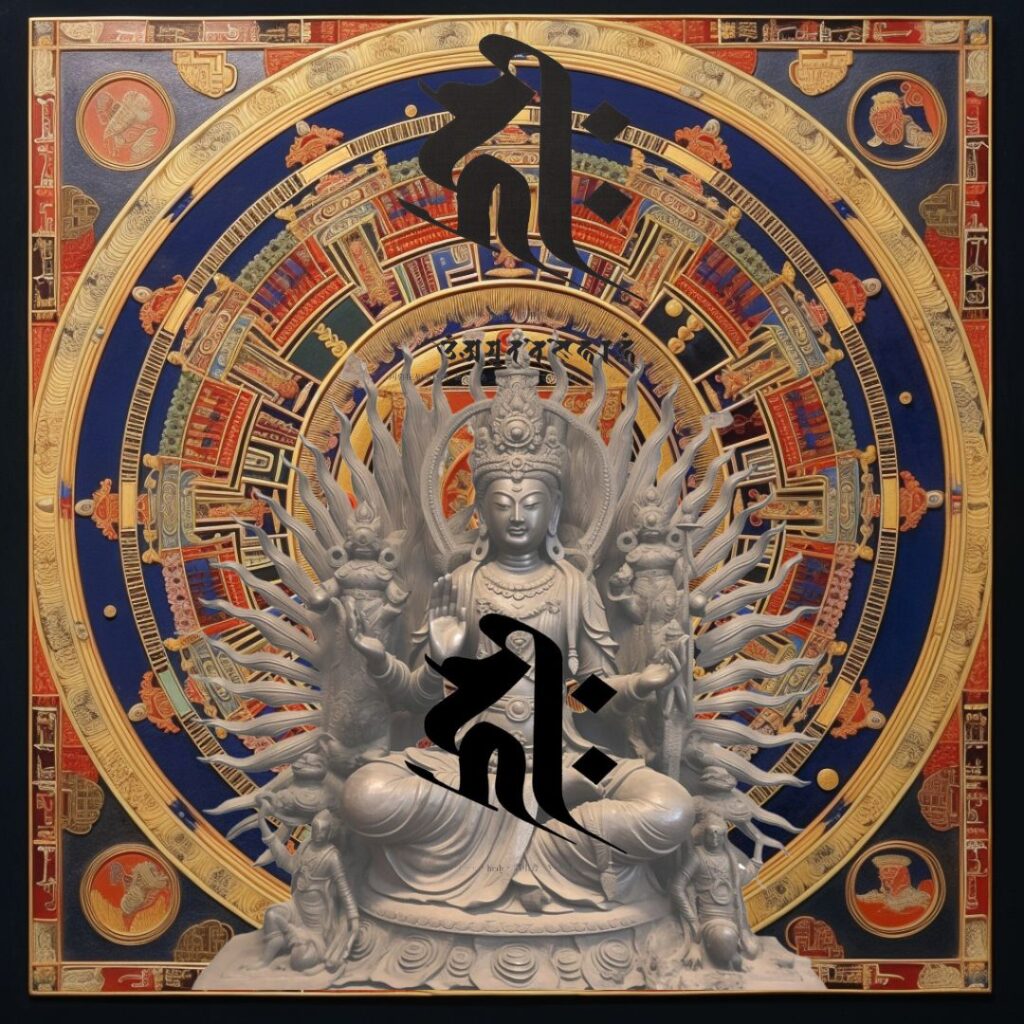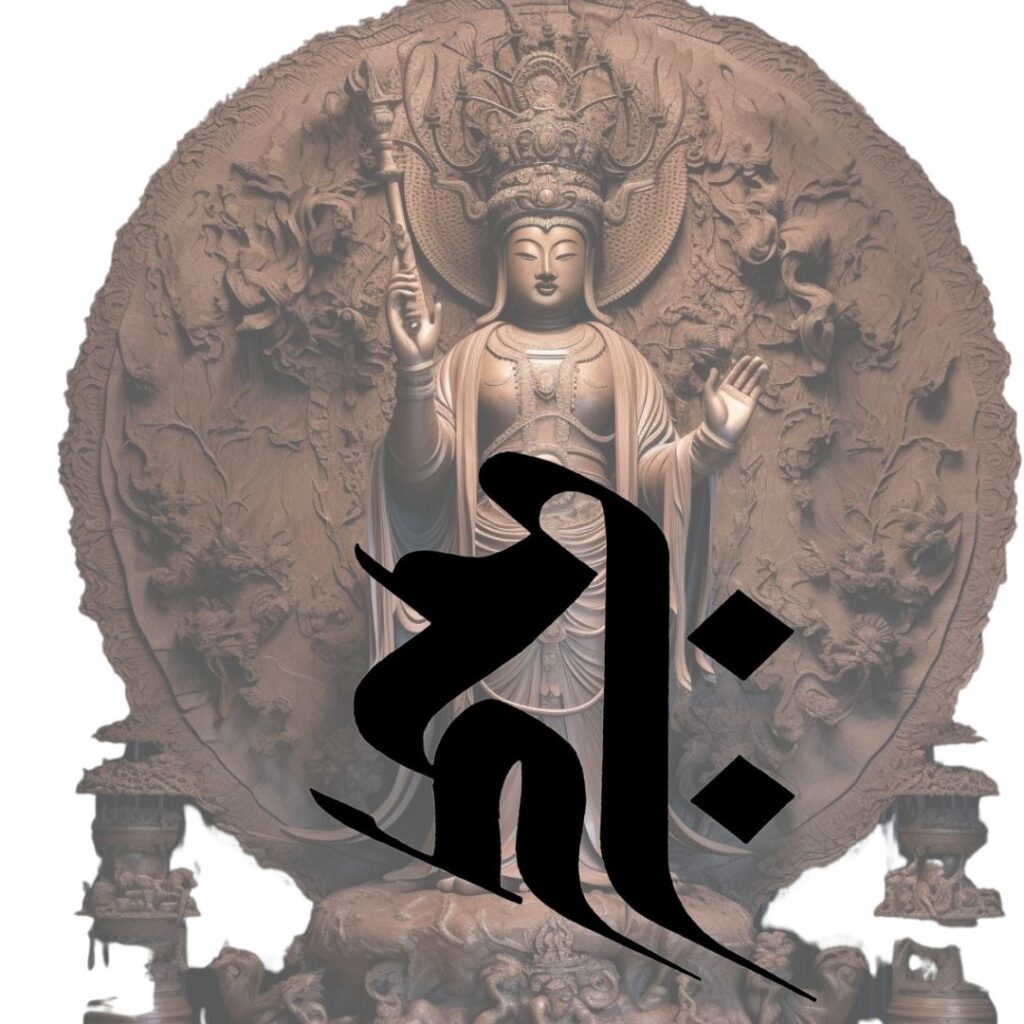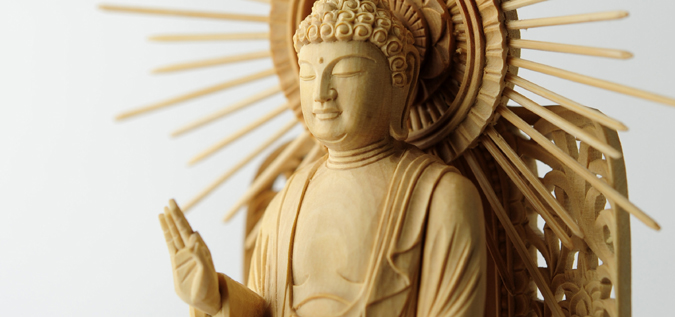摩訶止観の瞑想法想法
、二種類の瞑想法を解説する。
。
天台系の「摩訶止観」である。
これは、さきにのべた天台智顗の『天台小止観』一巻をもとにしてつくられた瞑摩訶というのは、大きな偉大な”という意味。 止は、さきにのべたように、 サンスクリット語の Samatha の訳で、心を平静にたもって一つの対象に集中する こと。観は、Vipaśyanā の訳で、 止によって得た正しい智慧により、ものごとを正しく観察理解することである。 要するに瞑想の根本技法である。 止と観をさまざま 駆使することにより、神秘的な飛躍・転換の体験が得られるのである。
以下、『天台小止観』一巻にもとづいて、解説しよう。
この本は、まことに綿密に書かれていて、たとえば、止観を修していれば身心が 調和して健康であるはずだが、ときに、かえって病患を動かす (持病などが表面に 出てくることがある。 その時には、早くこれをなおさなければいけないと、止観 による治療法までのべている。
瞑想を習うためには最もよい指導書と思われるので、これを紹介しよう。 なお、 原本は漢文なので、関口真大博士の口語訳によったことをおことわりしておく。 (観を修することによって、かえって病患を動かすことがある、ということにつ いて、これは非常に重大なことなので、あとでさらにふれることにする)
瞑想に入る前の五つの調和法
まず五法を調えよとある。
五法とは、一に飲食を調節すること。 二に睡眠を調節すること。 三には身を 調えること。四に気息を調えること。 五には心を調えることである。
第一に、食を調えるというのはつぎのようなことである。
食事はほんらいからだをたすけ正しい道にすすましめるためのものである。 それなのに、もし食べすぎているような状態でいると、気はあせり、からだは だるく、心がとぎれがちで、座禅をしても心は安らかになりにくい。
だが、もし食べることが少なすぎて足りないと、からだは疲れ、心は呆け、 思うところも考えることもしっかりとしない。 この二つは、どちらも禅定を得 る道にはならない。
しげきぶっ
また、もしけがれたものやよごれたものを食べていると、ひとの心をく し、迷いやすくする。 もしからだによくない刺激物を食べていると、かねてか の病が動いてくるし 持病が出ること)、からだの調子も悪くなる。だから 禅定を修習しようとするなら、そのはじめにぜひとも深くこれらをつつしまな ければならない。
第二に、睡眠を調えるというのは、眠とはこれ無明が心に覆いかぶさるので あるから、これをほしいままにしてはならないということだ。
眠ることが必要度を過ぎて多いときは、それだけ仏法を修習する時間が 廃されるだけでなく、努力の心も失われがちで、しかも心をくらくしい心 沈没させる。まさに人生が無常であることをさとり、睡眠をよく調伏して、気分を清白に、心を明るくきよからしめるがよい。
第三には、身を調え、第四には息を調え、第五には心を調えるのであるが、 この三つの条件は、まさに合わせて用うべきなので、べつべつに説明すること はできない。以下これについて述べてみよう。
第一に身を調えるとは、われわれが正しい瞑想をするためには、からだを正 しく調えなければならないということである。
瞑想をはじめる前から、歩くときにも立ち止まるときにも、動くときも静か にしているときも、なにかをしているときでも、いちいちがみな注意深く綿密 でなければいけない。
もし動作が粗雑であれば、息づかいもそれだけみだれる。 息づかいがあらい
と、心もみだれておさめにくくなる。 座禅をしてみても、心がみだれがちで、 落ち着いた気分にはなりにくい。
だから座禅をはじめる前から、あらかじめ注意していなければならない。 のように用心しておいて、いざ座禅をはじめようとするときには、なおよく身 も心も落ち着けるような所をえらぶようにしなければならない。
はじめて座るべき場所についたら、その場所にしっかりと落ち着かなければ いけない。つねに安穏にしていられるようであれば、いつまでもさまたげられ ることはない。
つぎにはまさに脚から姿勢を正しくすべきである。
もし半跏趺座といわれる座りかたならば、左の脚を右の脚の上におき、それを引きつけて身に近づけ、左脚の指と右のとをそろえ、右脚の指と左のともし結跏趺座といわれる座りかたをしようとするなら、さらに下にある右の
Makashikan’s Meditation Imagination
describes two types of meditation.
.
It is a Tendai-style “Makashikan”.
This is based on one volume of Tendai Chiho’s “Tendai Kodigan”, which was mentioned earlier, and means “meditation is great and great.” Translated from the Sanskrit word Samatha, to keep one’s mind calm and focused on one object.Vipaśyanā, translated from Vipaśyanā, means to observe and comprehend things correctly through the correct wisdom gained by stopping. It is a fundamental technique of meditation.By making full use of various stop and views, you can experience a mystical leap and transformation.
Below, I will explain based on the first volume of “Tendai Kodomekan”.
This book is very meticulously written. For example, if you practice shikan, your body and mind should be in harmony and you should be healthy. At that time, it is said that this must be corrected as soon as possible, and even a treatment method based on the contemplation.
I would like to introduce this as it seems to be the best guidebook for learning meditation. Since the original is written in Chinese, I would like to point out that it was translated into colloquial by Dr. Shindai Sekiguchi. (As for the fact that by cultivating our views, we can actually move the sick, this is a very important point, and I will touch on it further later.)
Five Harmony Techniques Before Entering Meditation
It says to study the five laws first.
The five laws are the first to regulate eating and drinking. Second, regulate your sleep. Third, take care of yourself. Fourth, keep your breath. Fifth, prepare your mind.
First of all, preparing meals is as follows.
Food is really meant to help the body and keep it on the right path. And yet, if he is in a state of overeating, he becomes impatient, his body is sluggish, his mind tends to be restless, and it is difficult to calm his mind even when he sits in meditation.
But if you eat too little and not enough, your body will be tired, your mind will be dull, and you will not be able to think and think clearly. Neither of these two are paths to attain meditation.
Shigekibu
Also, if one eats something unclean or unclean, one’s heart will be broken and it will be easy to get lost. If you eat irritants that are not good for your body, you will develop a long-standing disease (or chronic disease), and your body will get worse. Therefore, if one wishes to practice meditation, he must at the very beginning be a person who thoroughly understands these things.
Secondly, arranging sleep means that sleep is because ignorance overwhelms the mind, and he is not allowed to do so.
When you sleep more than you need, not only will you lose the time to practice Buddhism, but you will also tend to lose your spirit of effort, and your mind will become dull and sink. Realize that life is impermanent, get a good night’s sleep, clear your mind, and make your mind bright and pure.
The third is to prepare the body, the fourth is to prepare the breath, and the fifth is to prepare the mind. Let’s talk about this below.
Firstly, arranging the body means that in order for us to meditate properly, the body must be properly arranging.
Even before you begin to meditate, whether you walk or stand still, whether you are moving, whether you are still, whether you are doing something, you must be careful and thorough.
If the movements are sloppy, the breathing will be all the more disturbed. shortness of breath
And my heart is confused and it becomes difficult to calm down. Even if you try to sit in meditation, your mind tends to be confused and it is difficult to feel calm.
Therefore, even before starting zazen, you must be careful in advance. When it comes time to begin zazen, you should choose a place where you can calm down both physically and mentally.
When he first gets to where he should sit, he has to settle down firmly in that spot. If you can always remain calm, you will never be disturbed.
Next you should correct your posture right from the legs.
If you are sitting in a half-lotus position, place your left leg on top of your right leg, pull it close to your body, align your left toes with your right, and right toes with your left. If you want to sit in a tongs position, you can go further down to the right
脚ももち上げ、それを左の脚の上に置く。
つぎに衣帯を解きゆるめる。
しかし、ゆるめすぎて、座っているときに脱げて落ちたりすることがないようにしなければいけない。つぎに手を落ち着ける。左手の掌を右手の上に置 き、両手をかさね、あい対してこれを落ち着け、ともに左脚の上に置き、 ひき つけて身に近づけ、下腹に当てて落ち着ける。
つぎに身を正しくする。
まず、そのからだならびに手足や肢節をゆり動かすこと、七、八度くらいす るがよい。また、自分でからだを揉みほぐして、手足にしこりを残さないよう にする。つぎには身を正しくする。 それには全身を端正にし、背骨をまっすぐ にして、曲がったり、反り返ったりすることのないようにする。
つぎに、頭を正しくする。
鼻とヘソが垂直線上にあるようにし、それがかたよらず斜めならず、 うつむ かず、また、反り返らないようにし、正しく住する。
つぎに口を開き、胸中の穢れた気を吐き去る。
気を吐く方法は、口を開き、気を放つが、思うぞんぶんにそれを吐き出す。 そのときからだのなかのぐあいのわるいものをことごとく放ち、それが吐く息 にしたがって出てゆくものと観想する。 出しつくしたら口を閉じ、鼻から清気 を入れる。このようにして三度ほどくりかえす。 身息が調和しさえすれば、一 度だけでもよい。
つぎに口を閉じる。
と歯を上下かるく自然に合わせ、舌はもちあげるようにして上顎に向け る。そして、眼を閉じる。 わずかに外光を断つ程度でよい。それが終わったら 正座姿勢を正しくして正座する)すること、石のごとくであれ。身や 首や手足をこまかく動かすようなことがあってはならない。
以上がはじめに禅定に入るときに身を調える方法である。 要をあげていえ ば、寛ならず急ならざること。これが身体の調った相である。
座禅に際してどう呼吸を調えるか
<呼吸の四つの相
つぎに、はじめて座禅に入るときに息を調える方法について述べよう。
呼吸にはおよそつぎのような四種類の相がある。
一に風、二に、三に気、四に息という。
この中の前の三種は調わない相で、後の一種、息だけがよく調った相であ
ところで風といわれるのは、座禅のとき、鼻のなかの息に出入の音があるの が、それである。
嘘の相とは、座禅のとき、呼吸に音はしないけれども、息の出入に結滞があ って、なめらかでないことを端という。
気の相とは、座禅のとき、音もなく、また結滞もないけれども、出入がなめ らかでないのを、気という。
息の相というのは、声もなく、結滞もなく、粗くもなく、出入が綿々とし て、息をしているのかしていないのかわからないようになり、身をたすけて安 穏に、よい気持ちになる。 これが息である。
風といわれる状態でいると、気が散る。嘘といわれる状態の呼吸をつづけて いると、心にむすばれができやすい。気といわれる状態の呼吸をつづけている と、やがて疲れがでる。息といわれる状態の呼吸をつづけていれば、 心が落ち 着いて、やがて定まってくる。
つまり、風、、気の三種の相があるときは、これを調わない呼吸といい、 座禅において思いのもととなる。心も定まりにくいのである。
呼吸を調える三種の法
もしこれらを調えようとするなら、まさにつぎのような三種の方法をこころ みるがよい。
第一には、精神をからだの下のほうに落ち着け、そこに精神を集結する。
第二には、身体を寛放してみる。
第三には、気があまねく全身の毛孔から出入していて、それをさまたげるも のがないと観想することである。
こうしてその心を静かにしていれば息も微々然となり、息が調えば、 思いは 生じないし、その心も定まりやすい。これがわれわれがはじめに座禅をすると 息を調える方法なのである。 要点は、渋ならず、滑ならず(渋とは渋滞 滑とは行きすぎのこと)というのが、息の調った様子である。
この文章だけでは、初心者にはよくわからないかもしれない。師について学ぶ必 要があろう。
注瞑想において、呼吸は非常に重要である。 わたくしは最も重要であるとさえ 思っている。 さきにちょっとのべたが、仏陀釈尊は、特別な呼吸法を阿含経 でのべておられる。 天台智顗は、仏陀直説の阿含経を軽く見るという過ちを おかしたので、これを知らなかったのであろうと思われる。まことに残念なこ
とである。仏陀の呼吸法については、あとでくわしくのべる。
心を調えるには二つの方法がある
はじめに座禅をするときに心を調えるということには、およそ二つの意味が ある。
一つには、みだれがちな心をおさえて、外の余分なことに向かって出した りしないようにすること。二つには、まさに沈・・・急ほどよく調和させ ることである。これについて説明しよう。
座禅をしていて、心がうす暗く、記憶もはっきりせず、頭がどうしても低く 垂れがちになることがある。 これを沈という。そういうときは、精神を鼻の頭 に集中し、思いをつねに一つのことに集中して、分散させないようにする。こ 沈をなおす方法である。
浮というのは、座禅をしていて心が好んでゆれ動き、からだもまた落ち着か ないで、ついほかのことを考えたりしてしまうことである。そういうときに
は、心を下方に向けて落ち着け、精神をヘソに集中し、みだれがちな心を制す るようにする。心が定まって落ち着けば、心は安静になる。 要点をあげてこれ をいえば、沈ならず浮ならず、 これ心が調った様子である。
問う。心に寛急の相があるかどうか。
答う。それはある。定心が急である相とは、座禅のときに座禅の中に心のは たらきの全体を集め、それによって禅定に入ろうと強く努力することに原因て起きる。 それゆえに、気が上方に向かいがちで、胸が急に痛むようなこと がある。そんなときには、一度その心をとき放した上に、気はみな流れ下ると想うがよい。それだけで思いは自然におさまる。
瞑想中、瞑想後の心得
心が寛である相とは、心志がだらけ、からだが斜めにのめりこむような気持 ちがしたり、あるいは口からヨダレが流れたり、あるときは心が暗くなったり する。そのようなときにはまさに姿勢をきちんと正して心をひきしめ、心を一 つのものごとのなかに集中し、身体をしゃんとする。 それでなおる。 心に渋の 相と滑の相があることも、これらからして類推して知られるであろう。 以上が
はじめに禅定に入るときの心を調える方法である。
また、瞑想のなかで、身は調和していても、呼吸が調和していないこともあ ろう。不調の相は、さきに説いたように、あるいは風、あるいは嘘であった り、あるいは気が急のため背中に張満するようなことがあれば、ただちに前の 法をもちいてこれをなおすべきで、つねに息を綿々としてあるがごとく、なき がごとくならしめる。
また、一座の瞑想のなかで、身と息は調っていても、 心があるいは沈、ある いは浮、あるいは寛、あるいは急であることがある。 そのときには、気がつき しだい、前の方法を用いて正しく調えなければいけない。
座禅中はいつでも、身・息・心の三事に調わないものがあるのに気がついた ら、そこでそれを適当に調えて、一座のなかでいつも身・息・心の三事を調 して、あいそむきみだれることのないようにすることが大事だ。 もしよく調和 し、とけ合って一つになっていれば、かねてからの思いさえも除かれ、障りや 妨げは生じないし、禅定の道もわがものとなる。
座禅をやめて定を出ようとするときの身・息・心の三事を調える方法につい て言おう。もし座禅を終わってまさに定を出ようとするときには、まずいまま でひきしめていた心をとき放って気持ちを楽にし、つぎに口を開いて気を放 ち、息が全身から意にしたがって外に布散していくと思うがよい。
そうしてからあとで、微徴と身を動かし、つぎに肩・および手・・ 頭頸などを動かし、つぎに両足を動かして、 みな柔らかならしめる。 そして それから後に、両手であまねく全身の毛孔を摩擦する。
つぎに掌を摩擦してあたたかならしめ、それをもって両眼をおおい、そのな かで眼を開く。そしてからだの熱い汗がやや止むのを待って、そこで自分の必 要に応じて動くがよい。もしそれらに注意しないと、座禅はある程度うまくで きたとしても、それをやめて禅を出るときにこれらの注意を欠くと細かい要素 がまだぜずにからだのなかに残っていて、頭の痛いことがあったり、からだ 節節が痛むこと、風労(気の疲れ、気の病い)のごときことがあったりす
るのである。身は俺で、息はその中間にあり、心は最も細静なるものである。 なるものを調えて、細なるものに就き、心を安静ならしめる。 これが禅定に 入るときのはじめの心がまえである。
座禅をするときに、一度はすでに身を調え終わっているが、座禅中に、身が 寛、あるいは急、あるいは偏、あるいは曲、あるいは低く、あるいは抑いだり していることに気がついたら、すぐに正さなければいけない。いつも安穏中正 で、なかに寛もなければ急もなく、平直にして正しく住せしめるのである。
Lift your leg up and place it over your left leg.
Next, untie the robe.
However, it should not be too loose and fall off while sitting. Then relax your hands. Place the palm of your left hand on top of your right hand.
Then straighten yourself out.
First, rock the body, limbs and joints, about seven or eight times. Also, massage your body by yourself so that you do not leave any lumps on your hands and feet. Next, straighten yourself out. To do this, keep the whole body straight and the spine straight, without bending or arching.
Then straighten your head.
The nose and the navel should be in a vertical line, and should not be slanted or slanted, nor should they be bowed or arched, and dwell right.
Next, open your mouth and exhale the filthy air in your chest.
The way to exhale is to open your mouth, release the energy, and let it out as much as you want. At that time, let go of all the bad things in your body, and visualize them coming out according to your exhaled breath. Close your mouth and let fresh air in through your nose. Repeat this three times. Only once is enough as long as the body and breath are in harmony.
Then close your mouth.
The teeth should be lightly aligned up and down, and the tongue should be lifted and directed toward the upper jaw. Then close your eyes. It is enough to cut off external light slightly. When that is over, correct your seiza posture and sit seiza), be like a stone. There should be no jerky movements of the body, neck, or limbs.
This is the way to prepare yourself when you first enter meditation. In short, he should be neither relaxed nor hasty. This is the toned phase of the body.
How to control your breathing during zazen
<Four phases of respiration
Next, let’s talk about how to hold your breath when you first enter zazen.
There are roughly four phases of respiration.
The first is wind, the second is qi, and the fourth is breath.
Among these, the first three phases are not well-tuned, and the latter one, only the breath, is well-tuned.
By the way, what is called wind is the sound of breathing in and out of the nose during zazen.
The false phase is when there is no sound in breathing during zazen, but there is stagnation in the inflow and outflow of the breath, and it is called the edge.
Qi phase means that there is no sound or stagnation during zazen, but the movement in and out is not smooth.
The breath phase is that there is no voice, no stasis, no roughness, the comings and goings are smooth, and he becomes unsure if he is breathing or not, helps himself, is at peace, is good. I feel This is breath.
Being in a state called wind is distracting. If you continue to breathe in a state that is said to be a lie, it is easy for your mind to become connected. If you continue to breathe in the state called qi, you will eventually get tired. If you continue to breathe in the state called breath, your mind will become calm and settled.
In other words, when there are three phases of wind and qi, this is called unbalanced breathing, and it is the basis of thoughts in zazen. It is also difficult to settle the mind.
Three ways to adjust your breathing
If you want to find out about these things, just try the following three methods.
First, place the mind in the lower part of the body and concentrate it there.
Second, let your body relax.
The third is to contemplate that the mind is flowing in and out of every pore throughout the body, and that he has nothing to block it.
If you keep your mind quiet like this, your breath will be faint, and if your breath is fine, thoughts will not arise, and your mind will be easy to settle. This is how we catch our breath when we first sit in meditation. The main point is that it is not astringent and not slippery (“Shibu” means traffic congestion, and “Suri” means going too far).
This article alone may not be very clear to beginners. You will need to learn about your teacher.
Breathing is very important in note meditation. I even consider it the most important. As I mentioned a little earlier, the Buddha Shakyamuni speaks of a special way of breathing in the Agon Sutra. It seems that Tendai Chigi did not know this because he made the mistake of taking lightly the Agon Sutra directly taught by the Buddha. I am very sorry
and I will talk more about Buddha’s breathing method later.
There are two ways to prepare your mind
He has roughly two meanings in preparing the mind when he first sits in meditation.
For one thing, he should try to keep his turbulent mind in check and not let him get carried away with extraneous things outside. The second is to be very calm… to harmonize as quickly as possible. Let me explain this.
When I meditate, my mind is gloomy, my memory is not clear, and my head tends to hang low. This is called shen. At such times, keep your mind focused on the tip of your nose, your mind always on one thing and not scattered. It is a method to fix this sinking.
Floating means that when you are sitting in meditation, your mind will sway and your body will not settle down, and you will inadvertently think about other things. at that time
Let him turn his mind downward, calm his mind, concentrate his mind on the navel, and control his turbulent mind. When the mind is settled and calm, the mind becomes quiet. To sum it up, it’s not sinking, it’s not floating.
ask. Whether there is an aspect of leniency in the mind.
answer. It is. The phase of quick concentration arises due to the fact that in sitting meditation the mind gathers in it all of its activities and thereby makes a strong effort to enter meditation. Therefore, the qi tends to move upward, and there are times when the chest suddenly hurts. In such a case, let go of that mind once and think that all qi will flow down. With that alone, your thoughts will subside naturally.
Mindfulness during and after meditation
A relaxed state of mind means that the mind is full of intentions, and the body feels like it is sinking in diagonally, or drools flow from the mouth, and sometimes the mind becomes dark. At times like these, you should straighten your posture, tighten your mind, focus your mind on one thing, and straighten your body. That’s it. From these, it can be inferred that the mind has an astringent phase and a smooth phase. More than
It is a way to prepare the mind when entering meditation.
Also, in meditation, the body may be harmonious, but the breath may be out of harmony. As I said before, if you have a bad condition, or if it is a wind, or a lie, or if you are in a hurry and your back is full, you should immediately use the previous method to remedy it. So, he always breathes like he’s still there, like he’s gone.
Also, in troupe meditation, even if the body and breath are in harmony, the mind may be calm, floating, relaxed, or sudden. At that time, it is up to him to come to his senses and use the previous method to get it right.
During zazen, whenever you notice that there is something that is not in harmony with the three things of body, breath, and mind, you should adjust it accordingly, and always adjust the three things of body, breath, and mind in the troupe. , it’s important not to get frustrated. If one is well harmonized and melted into one, even long-held thoughts will be removed, obstacles and hindrances will not arise, and the path of meditative meditation will become one’s own.
Let’s talk about how to prepare the three things of body, breath, and mind when you stop zazen and try to get out of meditation. When he is about to leave the sedation after zazen, he must first release his tense mind and relax, then open his mouth and let the air out, and the breath will flow out of his whole body according to his will. Think of it as spreading.
After that, move your body, then move your shoulders, hands, head and neck, then your legs, and soften them all. And he then rubs his hands all over the pores of his body.
Next, rub your palms together to warm them, cover your eyes with them, and open them with your hands. Then wait for the hot sweat of your body to cease a little, and then move according to your needs. If you don’t pay attention to them, even if you can do zazen well to some extent, when you quit and leave zazen, if you don’t pay attention to these details, the details will still remain in your body and you will have a headache. There are times when the joints of the body hurt, and there are things like wind labor (tiredness of mind, sickness of mind).
It is. My body is me, my breath is somewhere in between, and my mind is the quietest. Prepare what is, take care of what is small, and calm your mind. This is the initial mindset when entering meditation.
When you do zazen, you have already prepared yourself once, but during zazen, if you notice that your body is relaxed, steep, biased, curved, low, or restrained, , must be corrected immediately. There is always peace and tranquility, neither leisure nor urgency.
